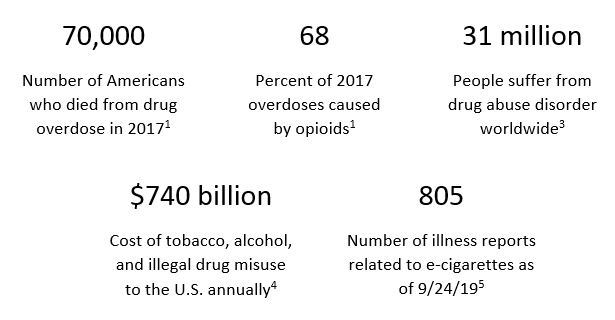Drug use is a hot topic these days as the opioid crisis rages on and the government looks to ban flavored e-liquids for vaping.

Common health issues related to drug abuse include changes in sleep, appetite, heart rate, blood pressure, and mood. Extreme cases can include respiratory depression, heart attack, stroke, or cancer.6 There are multiple ways to treat drug abuse including behavioral counseling, medication, medical devices, and mental health therapies.7 Ongoing research looks to further understand the effects of using various drugs on the body, the effects of withdrawal, and to optimize treatment options.
There are several different animal models used in drug abuse studies, depending on what researchers are looking to understand. Some may look at self-administration models, drug-seeking models (cravings), or models of relapse and addictive behavior.8 Rodents are the most common animals used in these types of studies due to their low cost and ability to be genetically modified to mimic human responses. Some studies utilize larger animals such as primates as they are naturally more physiologically similar to humans. Preclinical researchers in this realm often study endpoints such as body temperature, locomotor activity, behavior, as well as various cardiovascular and respiratory endpoints.

Drug use related studies citing use of DSI solutions
The following are a few examples of drug use related studies using DSI solutions to monitor physiologic endpoints.
Ventilatory-depressant effects of opioids alone and in combination with cannabinoids in rhesus monkeys
Respiratory depression is most common cause of death related to opioid use as the therapeutic window for them is very narrow, requiring high doses to be effective. This study aimed to understand whether combining opioids with other drugs would widen the therapeutic window, thereby reducing patients’ risk of developing respiratory depression. Respiratory endpoints from a primate model were measured with a helmet plethysmograph and signals were brought into DSI’s Ponemah software to calculate respiratory rate, tidal volume, and minute volume. The study results indicate a larger therapeutic window for opioids when combined with cannabinoid receptor agonists.9
Buprenorphine Depresses Respiratory Variability in Obese Mice with Altered Leptin Signaling
In humans, obese and female patients are reported to have an increased risk for respiratory depression when taking opioids. This study hypothesized that gender, body weight, and leptin status together increase risk. To test this, the research team used DSI’s Buxco® whole body plethysmography system to measure minute ventilation in rats of both sexes, of obese and normal body weights, and with different leptin signaling. The study data showed mice with impaired leptin signaling showed the greatest decrease in minute ventilation variability when exposed to the opioid buprenorphine. This indicates impaired leptin status poses a greater risk of respiratory depression regardless of gender or body weight.10
Effects of nicotine and THC vapor inhalation administered by an electronic nicotine delivery system (ENDS) in male rats
With increasing popularity of electronic nicotine delivery systems (ENDS) for both nicotine and THC, it is important to fully understand the effects on the body. To date, research is limited in this space, and this study aimed to validate a rat model to study the effects of nicotine and THC delivered through vapor inhalation. Both nicotine and THC are known to have a hypothermic effect, so the research team used DSI’s TA-F40 telemetry implant to monitor body temperature during and after exposure. Body temperature post-nicotine exposure decreased more rapidly after inhalation than with THC, and when the two were combined, the hypothermic response mirrored that of nicotine alone. This indicates there is a parallel, not interactive, effect when using nicotine and THC simultaneously. The study results successfully validated the model for future studies of ENDS inhalation of nicotine and THC in rats.11
Lasting effects of repeated ∆9-tetrahydrocannabinol (THC) vapor inhalation during adolescence in male and female rats
Views of cannabis in society are increasingly moving toward decreasing perceptions of harm and legalization continues to grow, highlighting a need to fully understand the short and long-term effects of exposure. This study exposed male and female adolescent rats to THC vapor or propylene glycol (PG), a major ingredient of e-liquids and cartridges used in e-cigarettes, via inhalation twice a day for 30 minutes. They assessed the thermoregulatory response using DSI’s TA-F20 telemetry implant. The research team also studied the rats into adulthood to determine if there’s an associated risk of intravenous self-administration of oxycodone or fentanyl later in life with THC exposure in adolescence. The study results showed female adolescent rats developed a tolerance to THC’s hypothermic effects in the first week of exposure. Both sexes showed tolerance in adulthood, but THC-exposed males consumed more food than males exposed to PG. THC exposure in adolescence did not appear to affect self-administration of oxycodone, but they did see an increase of fentanyl self-administration in females. The results indicate lasting consequences of THC vapor inhalation in adolescence.12
Take your research to the next level
Looking for solutions for your drug use or addiction research? We would love to learn about your specific study needs so we can work together to put a plan in place to ensure your success. Schedule a free consultation with us and let’s get started!
Whether you’re looking to create an animal model, assess drug effects on animal physiology, or evaluate addiction treatments, DSI has a solution. Below is a high-level overview of the most commonly used solutions.
Drug Delivery & Model Development - Inhalation Solutions
DSI offers several options for delivering drugs to create an animal model of drug use or addiction. The inhalation exposure system allows researchers to deliver a drug to multiple subjects simultaneously in a controlled, uniform manner. Unlike many inhalation towers, the DSI tower allows integration of plethysmographs to measure respiratory endpoints during and immediately following exposure. For smoking and vaping studies, DSI offers options to deliver smoke through the inhalation tower. Buxco respiratory solutions can also be used to deliver a drug via nebulization.

Drug Effect Assessment & Treatment Evaluation – Telemetry and Respiratory Solutions
Telemetry
DSI telemetry allows for continuous collection of physiologic signals to assess effects such as thermoregulatory, cardiovascular, neurological, metabolic, and more in conscious, freely moving animals. Telemetry improves animal welfare by reducing stress (less handling, no restraint) and the number of animals required to complete a study.

Respiratory
DSI’s Buxco Respiratory Solutions allow direct or indirect measurement of respiratory endpoints including respiratory rate, minute volume, and tidal volume. As mentioned above, respiratory depression is the most common cause of death in opioid overdoses. As a result, many studies are interested in collecting respiratory endpoints.

Did you miss our recent webinar?

The opioid crisis can be traced back to the 1990s. Amid rising demand for pain relief, pharmaceutical companies assured doctors that their drugs carried little risk of addiction, and doctors began prescribing them at a higher rate. Since then, prescription, production and misuse of opioids have risen dramatically. In this webinar, Dr. Ralph Lydic and Dr. Tally Largent-Milnes discuss the role of respiratory and neuroscience research in addressing the opioid epidemic. Now available on demand!
Dr. Ralph Lydic presents data demonstrating the systemic and neurological effects of opioids on breathing and sleep in rodent models. Following, Dr. Tally Largent-Milnes presents research investigating how cannabinoid receptors modulate opioid-induced respiratory depression in rodent models.


Ralph Lydic, Ph.D. Tally Largent-Milnes, Ph.D.
Professor of Neuroscience Assistant Professor of Pharmacology
Co-Director of Anesthesiology Research University of Arizona
University of Tennessee

References
- Centers for Disease Control (2019). “Drug Overdose Deaths”. https://www.cdc.gov/drugoverdose/data/statedeaths.html
- Rosenberg J. (2019). “5 Updates on Trends in Drug Overdose Deaths in the United States”. American Journal of Managed Care. https://www.ajmc.com/newsroom/5-updates-on-trends-in-drug-overdose-death--in-the-united-states
- World Health Organization. (2019). “Management of substance abuse”. https://www.who.int/substance_abuse/facts/en/
- National Institute on Drug Abuse. (2019). “Trends & Statistics”. https://www.drugabuse.gov/related-topics/trends-statistics
- Centers for Disease Control and Prevention. (2019). “Outbreak of Lung Injury Associated with E-Cigarette Use, or Vaping”. https://www.cdc.gov/tobacco/basic_information/e-cigarettes/severe-lung-disease.html
- National Institute on Drug Abuse. (2019). “Health Consequences of Drug Misuse”. https://www.drugabuse.gov/related-topics/health-consequences-drug-misuse
- National Institute on Drug Abuse. (2019). “Treatment Approaches for Drug Addiction”. https://www.drugabuse.gov/publications/drugfacts/treatment-approaches-drug-addiction
- Spanagel R. (2017). “Animal models of addiction”. Dialogues in Clinical Neuroscience, 19(3): 247-258. https://www.ncbi.nlm.nih.gov/pmc/articles/PMC5741108/
- Weed PF, Gerak LR, France CP. (2018). “Ventilatory-depressant effects of opioids alone and in combination with cannabinoids in rhesus monkeys”. European Journal of Pharmacology, 833: 94-99. https://www.sciencedirect.com/science/article/pii/S0014299918303108
- Angel C, Glovak ZT, Alami W, Mihalko S, Price J, Jiang Y, Baghdoyan HA, Lydic R. (2018). “Buprenorphine Depresses Respiratory Variability in Obese Mice with Altered Leptin Signaling”. Anesthesiology, 128: 984-991. https://anesthesiology.pubs.asahq.org/article.aspx?articleid=2672054
- Javadi-Paydar M, Kerr RM, Harvey EL, Cole M, Taffe MA. (2019). “Effects of nicotine and THC vapor inhalation administered by an electronic nicotine delivery system (ENDS) in male rats”. Drug and Alcohol Dependence, 198. http://www.ljari.tech/wp-content/uploads/2019/03/javadipaydar19-nicotinevape-corrproof.pdf
- Nguyen JD, Creehan KM, Kerr TM, Taffe MA. (2018). “Lasting effects of repeated ∆9-tetrahydrocannabinol (THC) vapor inhalation during adolescence in male and female rats”. bioRxiv. https://www.biorxiv.org/content/biorxiv/early/2019/07/24/426064.full.pdf